Author | Binance Research
Translation | Huohuo
The era of L2 Rollup is coming, and activities on Ethereum L2 have reached an all-time high. The average transactions per second (TPS) on L2 have surpassed Ethereum since the end of 2022.
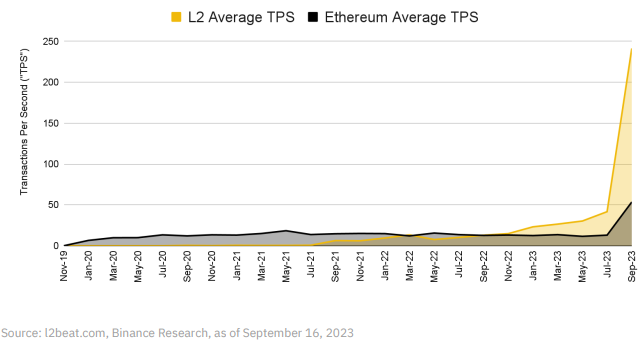
- LianGuai Observation | Evil exchange’s funding rate card is finally exposed by Binance after a month
- Digging deep into NFT whale holdings everyone is making money and showing off in various ways, only Ma Ji Big Brother is getting beaten up.
- AltLayer Research Report Introducing OPR Temporary Execution Layer, a Highly Flexible and Plug-and-Play RaaS Protocol
In the latest wave of L2 releases, many have used OP Stack, an open-source software that supports Ethereum L2, OP mainnet, and new participants like Base and Zora Network. Optimism envisions combining these Rollups and forming a decentralized L2 chain network, namely the superchain.
This article delves into OP Stack and the theory of the superchain, and then explores the evolving OP Stack ecosystem, including Base, Zora Network, DeBank Chain, and more. In addition, infrastructure solutions are discussed to enable developers and builders of various backgrounds to access this range of OP Stack chains.
01. About Optimism
Optimism is the company behind the OP mainnet, which is an Optimism Rollup similar to the Ethereum Virtual Machine (EVM). It has been running since 2021 and is one of the leading Ethereum Layer 2 solutions. As of the writing of this report, the total locked value (TVL) on the OP mainnet exceeds $2.6 billion and ranks second in market capitalization among all Ethereum Layer 2 solutions, with a market share of over 25%.
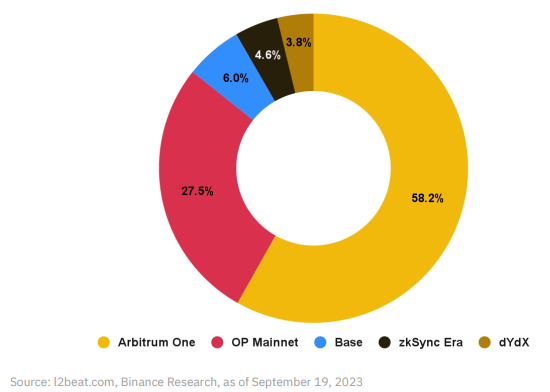
In October 2022, Optimism introduced OP Stack, which is a “highly scalable, highly interoperable modular open-source blueprint” for various types. It also introduced the concept of the superchain, which refers to a highly integrated and unified Layer 2 blockchain group built on OP Stack. The next major development is to migrate their L2 Rollup to Bedrock.
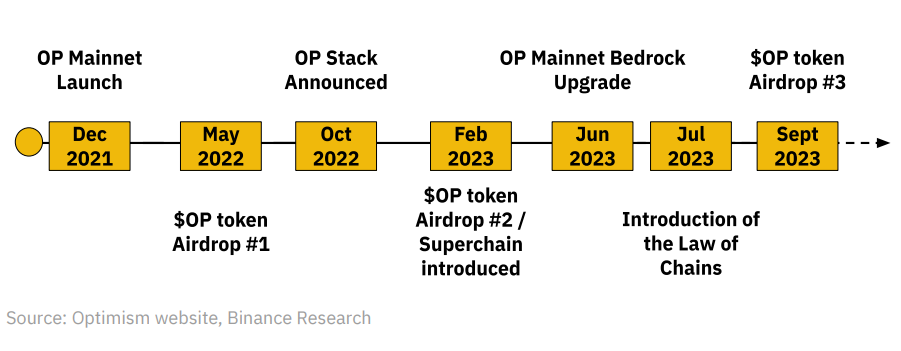
Optimism's short development timeline so far
OP Stack is a standardized, shared, and open-source development OPStack that supports the OP mainnet. It consists of various software components and builds Optimism’s L2 Rollup to create a shared, interoperable, and collaborative L2 blockchain network. OP Stack aims to simplify the construction of L2 blockchains, similar to a “supermarket for building L2,” allowing builders to easily modify or create modules to meet their specific needs.
Builders can modify existing modules or create new modules to fit their needs, and OP Stack deconstructs and packages different building L2 components into independent modules. Ultimately, Optimism expects highly compatible L2s, called OP chains, which will be part of the superchain.
The theory of the superchain is Optimism’s vision to upgrade its ecosystem into a superchain. The superchain is envisioned as a decentralized network of L2 chains (OP chains) that share security, communication layers, and the open-source technology Stack (OP Stack). These chains will be standardized and used as interchangeable resources to enhance chain interoperability.
This standardization will enable builders to create applications that target the entire superchain, rather than just applications running on the underlying chain. It should be noted that the superchain is currently a concept that is still being refined.

Superchain diagram
02, Growing OP Stack Ecosystem
Since the release of Bedrock in June 2023, we have seen many Rollup-based projects built on OP Stack. Next, let’s take a closer look at some of these star projects and major infrastructure projects.
Take a quick look at the table below, and we can see that Base is leading in terms of development. In fact, the cumulative unique address count of Base is even higher than that of the OP mainnet. The Onchain Summer activity of Base and its integration with Coinbase may be some key reasons for these relatively high numbers.
Please note that only the OP mainnet, Base, Zora Network, and the Public Product Network are on the mainnet, while the other three projects we cover are still in the testing phase.
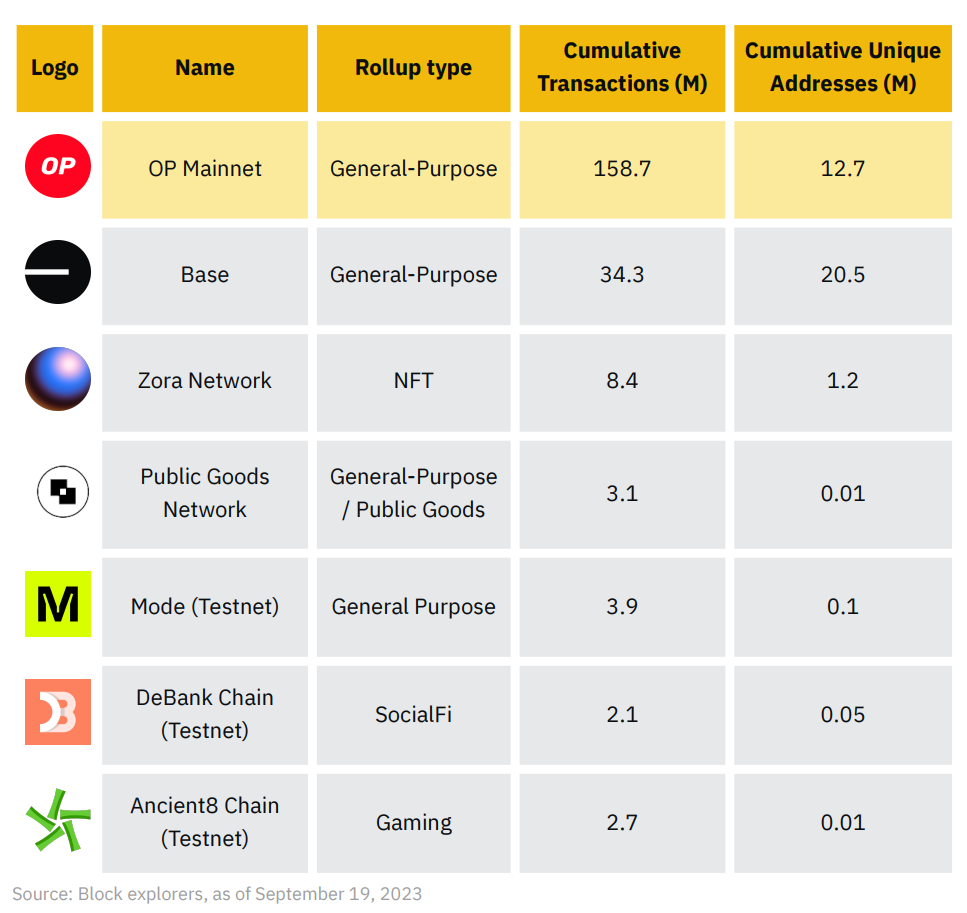
Notable Projects
Base
Base is one of the first announced OP Stack L2s (initially in February 2023) and launched their public mainnet on August 9th. Base is a generic L2 and is the most popular OP Stack chain after the OP mainnet.
The Onchain Summer was a month-long release event that coincided with the launch of Base, attracting multiple partners including Coca-Cola and jointly launching NFT Mint. This event attracted over 268,000 unique wallets from 75 unique series, generating over 700,000 Mints. The close association with Coinbase allows Base to have multiple integrations and provide convenient access to Coinbase users. Base has also launched over 100 dApps, and its ecosystem is growing.
In addition, friend.tech is a notable SocialFi platform that allows users to trade tokenized “keys” and has attracted a large user base and trading volume. However, it is still in the testing phase and future growth may require attracting non-crypto and Web2 users.
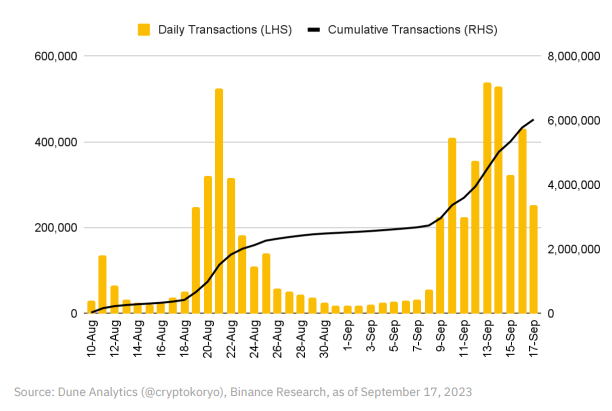 After the initial hype in mid-August, friend.tech’s daily trading activity slowed down significantly until it picked up again in recent weeks.
After the initial hype in mid-August, friend.tech’s daily trading activity slowed down significantly until it picked up again in recent weeks.
The Base Ecosystem Fund is led by Coinbase Ventures and focuses on supporting early-stage projects including DeFi, Fiat on/off-ramp, and creator platforms. In addition, the Base team has released Pessimism, an open-source monitoring system that enhances the security of OP Stack and other EVM-compatible chains, with a focus on detecting protocol threats and mitigating security risks.
 Since the launch of the mainnet in early August, Base’s user metrics have shown significant growth throughout September.
Since the launch of the mainnet in early August, Base’s user metrics have shown significant growth throughout September.
Based on the collaboration between Optimism and Base, they have reached an economic agreement where Base will donate 2.5% of the sequencer’s total revenue or 15% of net profit to Optimism, with the opportunity to win up to $118 million worth of OP Tokens over the next six years. Although not explicitly announced, other OP Stack chains may also have similar revenue-sharing agreements with Optimism, highlighting the importance of collective contributions to the infrastructure of superchains.
Zora Network
Zora Network is a decentralized, permissionless protocol that allows anyone to buy, sell, and create NFTs. In addition, they have launched their own OP Stack Layer 2 network to support users and reduce platform costs.
They launched their mainnet on June 21, 2022, providing a better user experience for NFT transactions as the cost of creating an NFT is less than $0.5 and offering many free Mint options. Compared to Ethereum, the block time of OP Stack is only 2 seconds, allowing transactions on Zora Network to be confirmed within seconds.
In addition, Zora Network has successfully raised a total of $60 million in three funding rounds, including a $50 million funding round led by Haun Ventures in 2022, bringing the company’s valuation to $600 million. These funds will help drive the development and growth of Zora Network in the NFT space.

Zora user metrics have been steadily growing since late July.
Public Goods Network
The Public Goods Network (PGN) is an L2 protocol designed to support public goods. Public goods refer to non-excludable and non-rivalrous products or services, such as parks, libraries, and road infrastructure, and in the digital realm, they can include open-source software, permissionless data, and AI models, among others. The development of PGN is led by Gitcoin and SuperModular and has received support from multiple public goods advocates, forming the Public Goods Alliance responsible for the management and organization of PGN.
PGN operates in a way that the majority of net sequencing fees will be used to support public goods projects, so as activity on L2 increases, the funding for public goods projects will also increase. PGN aims to attract various types of dApps to deploy on its L2, not limited to projects related to public goods. PGN plans to evaluate its fees and allocate them to public goods projects within six months before January 2024, with more details to be announced in the coming weeks.
In addition, PGN also plans to leverage Contract Support Revenue (CSR) after October 2023, which will allow developers to charge a certain percentage of fees generated from their contracts and support them in creating sustainable business models. CSR may become part of a broader L2 network and there have even been Ethereum Improvement Proposals (EIPs) suggesting the introduction of CSR on L2 of the EVM.

The user metrics of PGN steadily increased in August. Although the number of new accounts added in September has slowed down, the transactions continue to rise.
Mode
Mode’s positioning is to support high-speed growth of L2 networks and empower users and developers to build world-class applications and expand ecosystems through direct incentives. In achieving this goal, revenue sharing incentives play a crucial role.
Running L2 networks requires maintaining sequencers, which are responsible for ordering, processing, and delivering L2 transactions to the L1 mainchain. Typically, the transaction fees paid by users belong to DAO or sequencer operating companies. Mode aims to distribute these ordering fees to the developers and users of the network, rather than the company.
Developers based on Mode will receive a portion of the revenue from Mode’s sequencer based on the transaction fees they charge in the deployed contract. These fees are paid in USD and settled every two weeks. This approach allows developers to directly benefit from their work, helping to build predictable and scalable Web3 business models.
Mode encourages users, developers, and protocols to recommend new members to share a portion of the transaction fee revenue. They also provide support for developers to build applications and offer integrated development tools. Mode is developing a developer dashboard to provide key metrics and insights to help developers scale more easily. They also plan to integrate multiple external tools and services to help developers build sustainable businesses. Finally, Mode takes a minimal governance approach, only requiring DAO to vote on several key issues, including determining the allocation of ordering fee revenue.
Mode is approaching 4 million transactions and has over 36,000 independent accounts
Mode is currently on the public testnet and is expected to continue until the end of September. The mainnet is expected to launch in the fourth quarter of 2023.
DeBank
DeBank is a Web3 portfolio tracking protocol that offers a variety of products, including portfolio tracking systems, social networking services, and NFTs. DeBank Chain is their L2 chain based on the OP Stack, and is expected to launch in 2024.

The core goal of DeBank Chain is to reduce the transaction costs of user interactions within the DeBank ecosystem. By modifying the consensus mechanism, the gas cost of individual transactions has been reduced to better meet the high-frequency social interaction needs. In addition, DeBank Chain has directly built-in account abstraction functionality, while also generating protocol revenue. Since the launch of the testnet on August 11th, DeBank Chain has recorded over 2.1 million transactions, covering over 50,000 unique wallet addresses. In addition, DeBank has attracted over 250,000 registered users.
Ancient8 and Ancient8 Chain
Ancient8 has been operating as a gaming guild and aims to help gamers enter the Web3 world through collaborations with over 100 games. They have introduced Ancient8 Chain, which is an Ethereum L2 solution focused on gaming. The testnet of this chain was launched on September 15th. The vision of Ancient8 is to establish a complete gaming ecosystem, including NFT sales, game community development, game identity and credential creation, and project marketing. They have also established Ancient8 Collective, consisting of 8 core partners, to jointly build the Ancient8 Chain ecosystem. This project has raised $10 million in funding.
Although the testnet of Ancient8 Chain has only been launched for a few days, it has already recorded over 2 million transactions involving nearly 5000 independent accounts. These statistics demonstrate the popularity and growth potential of Ancient8 Chain in the Web3 gaming field.

The testnet of Ancient8 Chain is still in its early stage.
Infrastructure
Conduit
Conduit is a Rollup-as-a-Service (RaaS) platform that allows developers to easily launch their own Optimistic Ethereum (OP) Stack rollup. The Conduit team operates and maintains the rollup so that developers can focus on building their products instead of dealing with the infrastructure.
Since its mainnet launch in March 2023, various OP Stack chains, including Zora Network, Public Product Network, Ancient8 Chain, and Mode, have chosen to partner with Conduit to launch their products.

Conduit is a solution that helps easily launch and manage OP Stack L2 rollups. Developers can create their own L2 rollup, including block explorers, transaction trackers, and auto-scalable RPC, in a matter of minutes. Additionally, Conduit automatically updates the L2 for each partner and integrates with the Optimism superchain, while also supporting the Optimism Grants Program with a portion of the fees.
The integration of Conduit allows partners to connect with other infrastructure projects such as Zora Network and Axelar, enhancing the integrated infrastructure of Conduit and making it easier for rollups to expand their user base.
Conduit has raised $7 million in seed funding, led by LianGuairadigm.
AltLayer
AltLayer is a RaaS protocol that enables developers to launch Optimism Rollups. It supports multi-chain and multi-virtual machine worlds, including EVM, WASM, Solana VM, and Move VM, among others. Unlike Conduit, AltLayer supports various software development platforms. AltLayer is currently in the testnet stage.
AltLayer’s products include a no-code dashboard that allows users to create custom L2 rollups in minutes, as well as a Rollup SDK for developers who want to directly integrate Rollup services into their own products. AltLayer also provides a shared sequencer set, enabling cross-chain atomic transactions and message passing with other L2s launched alongside AltLayer.
AltLayer provides a core network called the Beacon Layer, which serves as an intermediate layer between the L2 execution layer and the data availability layer. The Beacon Layer supports various aggregation SDKs, data availability solutions, sequence sets, and interoperability platforms, increasing the flexibility and interoperability of Rollups.
The Flash Layer is a one-time application-specific Rollup that is particularly useful for high-traffic activities such as NFT Minting and mini-games. AltLayer also offers a standard Optimism Rollup as part of its platform, which is more suitable for long-term applications such as GameFi and SocialFi.
AltLayer raised $7.2 million in seed funding in 2022, led by Polychain Capital.

AltLayer's generic Rollup OP Stack supports multiple protocols
03. Summary
We are witnessing a surge in various computation stack chains, including general-purpose L2s like Base and Mode, as well as specialized chains like Zora Network, DeBank Chain, and Ancient8 Chain.
New features such as Conduit integration are simplifying the deployment and scaling of OPStack Rollups, making it possible for more L2 Rollups based on this stack. The combination of Conduit with OP Stack’s uniqueness and the use of specialized RaaS providers to develop ecosystems, as compared to competing L2/L3 frameworks like Arbitrum’s Orbit or zkSync’s ZK Stack, is an interesting development.
Ethereum Rollup metrics continue to set new records, and more dApps are choosing to deploy on L2 instead of L1, signaling the advent of the L2 aggregation era. EIP-4844, also known as Proto-Danksharding, is expected to significantly reduce L2 Rollup fees and improve their competitiveness. The high usage of L2, the convenient deployment of infrastructure such as OP Stack and Conduit, and the prospects of EIP-4844 will further drive the development of L2. We await eagerly to see how the future unfolds.
This article is an excerpt from the Binance research report “The OP Stack: What’s New?”. For the complete version of the report, please see the link below:
Original article link: https://public.bnbstatic.com/static/files/research/OP-Stack-Whats-New.pdf
Like what you're reading? Subscribe to our top stories.
We will continue to update Gambling Chain; if you have any questions or suggestions, please contact us!